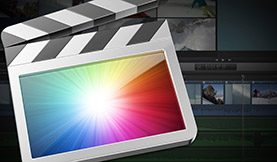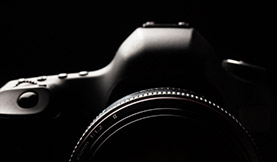Video Tutorial: Using Reformat Effects in Avid Media Composer
Work with footage of differing aspect ratios with ease! Use Reformat Effects to get everything on the same page.
Today’s video artists often need to constantly juggle dozens of various video formats within the same project, and this can lead to a tangled mess of different video sizes and aspect ratios. Fortunately, Avid Media Composer has several convenient reformat effects—the 16:9 and 4:3 letterbox effects, as well as the Pan and Scan effect—which you can use to bring all the clips in your sequence to a single aspect ratio.
This Avid Media Composer video tutorial will help you:
- Understand how various aspect ratios can combine in a single sequence
- Use the 4:3 Sidebar effect
- Use the 16:9 Letterbox effect
- Understand the difference between reformat effects and masks
- Use the Pan and Scan effect
- Subdivide the Pan and Scan effect
Full Video Transcription
Hello, this is Ashley Kennedy with Premiumbeat.com. I’m here to show you how to use various reformat effects in Avid Media Composer. Well take a look at the 16×9 and 4×3 letter box effect as well as the pan and scan affect. Now reformat effects are most often used when you have a mixture of footage with different aspect rations. For example, when you combine HD footage, which is 16×9, with SD footage, which can be 4×3, or when you combine different aspect ratios within SD footage, for example 16×9 and 4×3 and that’s what I have here. I have some shots that are in their correct aspect ratios, and some that are not. For example, this shot here was footage that was shot with 4×3 aspect ratio that is now in a 16×9 project so it sort of squeezes it and stretches it slightly to make it fit.
OK, so let’s go through our various options as far as how we can correct our aspect ratios and make everything look uniform. Now, when I come to the first shot that has an issue I have several options. The first is to apply a 4×3 sidebar, which is also called pillar boxing, and that’s found in the reformat effect category and I can just drag that onto the shot like so. And so, this is the correct aspect ratio. We have our 4×3 but we do have the pillar boxes on the left and on the right. So, it doesn’t exactly match when all the sudden we come to a shot that has this pillar boxing, but it is a way to correct the problem. If we come to this one, I want to show you another way to correct the problem. I can actually drag a pan and scan effect on and as you can see nothing happens right away. I have to open the affect editor., And here’s where I can do a little bit of stretching and squeezing, to make sure that I have the correct aspect ratio but I don’t have any pillar boxing. So what we’re going to do is we’re going to choose our source, which is 4×3, and our target, which in this case is 16×9, anamorphic and it gives us a wire frame which is basically telling us what portion of the shot we’ll see once it’s finished stretching and squeezing to fit it in to the correct aspect ratio.
So, I can move this up, I can move this down, I can even scale. But for right now I think that’s fine, just kind of centered and we have a little bit of head room and we don’t really need the bottom here. The moment I close this, we now have our subjects at the correct aspect ratio and we don’t have any pillar boxing. Instead what it’s done is zoom in, and we’ve lost a little bit of the area at the top and the bottom. Let’s go on to another shot here. So let’s do another pan and scan and we’ll open the effect editor. Again, this footage was shot in 4×3 and we’re going to 16×9 but if we take a look at this shot you can see that we’re going to run into a little bit of a problem toward the tail end of this. Because we’re really kind of cropping out an important area here. So what we can do with pan and scan is actually key frame this so that we don’t miss any important parts of the shot. I’m just going to put a key frame here, this one’s OK, keep going maybe until here and then we’re going to want to start moving it up so I’m just going to move it up. So, we’ve key framed it so that the wire frame travels up with the camera and let’s see how that looks. And you can see were at the correct aspect ratio now but we didn’t miss any of that important information up near the top of the shot.
OK so that’s key framing a pan and scan where we’re actually changing the area within the frame that we see by using key frames. But those are just options that you have once you start planning and scanning so you don’t have to have these pillar boxes to maintain the correct aspect ratio. Now I’d also like to show you a sequence with the opposite issue so I’m going to load the sequence here and we’ll change the project ration to 4×3 and so now the shots that have the problem before are now correct because we have a 4×3 shot and a 4×3 project and the shots that were correct before now have the issue. So, we have to do the opposite instead of applying a 4×3 sidebar, we have to come in and apply a 16×9 letter box. And so, because this has a color correction affect I don’t just want to drop it on. I want to option drag it so that I can auto next it if I was on PC that would ALT drag. Alright, so now we have a letter box effect around this shot so that it is in the correct aspect ratio. But again, side by side with this shot we’re going from something with a letter box to something without. So, we might want to use pan and scan again. Again, we’re going to option drag the pan and scan effect over. We’re going from 16×9 anamorphic to a 4×3. Here’s our wire frame, showing what portion of the shot we’re going to lose. So we can drag that around like so, can actually look through the effect to see if we want to key frame it, and in this case I don’t. So we’ll go ahead and just close it out and now we’ve got the correct aspect ratio with a little bit of information missing from the sides, but that’s OK. But we can go through and make sure that everything is displayed correctly, so that when we output it we have an aesthetically pleasing product.
Now I want to show you a couple more things about pan and scan. The first is to make sure that you know the difference between a letter box effect, which is in the reformat category, and a mask effect which is in the film category. So, I’m actually just going to remove this and instead of applying the letter box I’m going to apply the 16×9 mask, option drag. And you can see that nothing was done as far as the aspect ratio is concerned. All that was done was that the 16×9 mask was applied on top of this. So don’t get confused about that. A reformat effect actually doing the stretching and squeezing that we need in order to make it fit in the video frame. So here is the 16×9 letter box and you can see the difference.
And the last thing I want to show you is how to subdivide a pan and scan effect which basically means that I apply one pan and scan effect but every segment in my time line gets its own effect. So I’m going to add a video track above the rest, that’s command Y or control Y on a PC, apply the pan and scan and we’re going to come into our effect editor and choose what we want to have happen. Now, I’m going to come from 4×3 and what I’d like to do is produce a 16×9 output of this sequence. So we’ll go to 16×9 and you can see that I get my wire frame. But because the entire sequence has different parameters for where that wire frame is going to work, I would like to give each segment its own parameters. So I’m going to come down here and choose subdivide, and you can see what happened. Based on the video tracks below, put boundaries on this effect, so that every single segment in the time-line is getting its own effect.
So if we come to our first shot, we can see that we have some room to play with at the top and at the bottom. Maybe here I’d like this to be a little bit further up, but as we go forward, and that looks fine to me. Maybe we’d like this one to be a little bit further up here, so everybody’s getting their own parameter. We go forward like so and maybe we want to bring that down a little bit. WE can also key frame this to. Everything is key framable and the next one, and so on and so forth. So, we’re not limited by one pan and scan effect, but everything gets its own boundaries and we can really control what we’re seeing on the screen at any given time. OK, so you can see with as many video formats available out there is there are, you’ll constantly run into situations where you’ll have to negotiate frame size and aspect ratio. So use these tools, your letter boxes and pan and scan, to help keep your output accurate. And as always, remember to check back regularly at PremiumBeat.com for other screen casts where we explore lots of editing techniques in both Avid and Final Cut Pro. This is Ashley Kennedy with PremiumBeat.com.





